



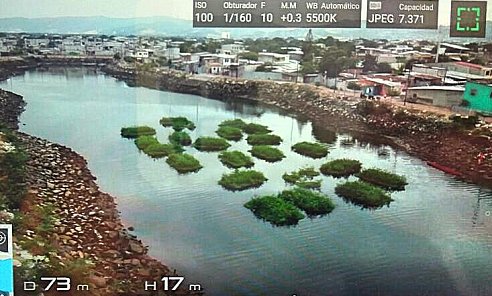
VITA Water Tech (Lethbridge) installed 4,200 sq ft of BioHavens and two streambeds in an estuary in Guayaquil to decontaminate the heavily polluted water from sewage. After 6 months the estuary was safe to swim again and marine life returned. In contrast to the installation picture (July 2017 - see below) the aerial picture taken July 2018, shows how the plants have prospered. The floating treatment wetlands (FTW) comprise plants, an extreme high surface area of the BioHaven matrix for the development of a biofilm and a streambed; all together they are a powerful tool to remediate water bodies. A streambed is an 'active' BioHaven that incorporates forced waterflow and aeration, improving greatly the performance of FTWs.
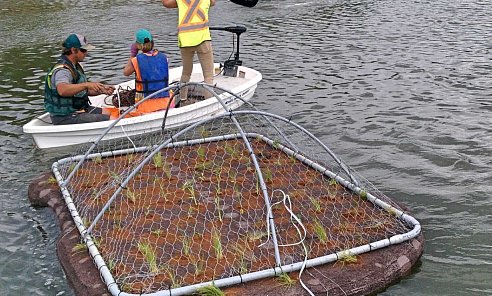
Lethbridge (AB) installs nine standard 88 sq ft BioHaven floating treatment wetlands in the Coulee Creek stormpond to improve water quality. The BioHavens have been installed with cages made from conduit and chicken wire to protect the young plant plugs from destruction by Canada geese. Once the plants are fully developed and have spread the cages can be removed if so desired.
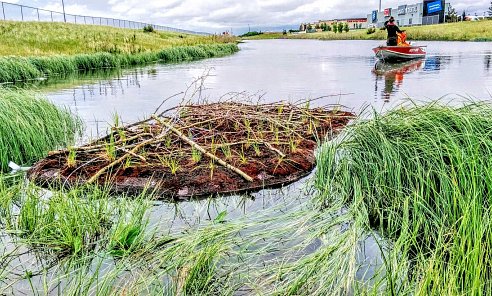
The City of Airdrie installs six 88 sq ft BioHaven floating treatment wetlands (FTWs) in Nose Creek, next to the QE2 highway. It is the City's fourth stormpond with FTWs to improve the waterquality. The picture taken at the time of installation, shows another succesful method to ward of big waterfowl by having large branches on top of the islands. Ducks still have the opportunity to enjoy nesting and relaxing on the islands.
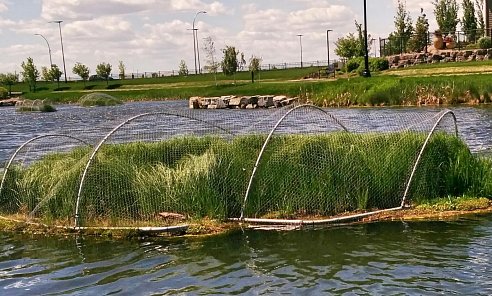
In certain locations with extensive waterfowl populations such as Canada geese, the young plant plugs initially installed on the floating islands are vulnerable to destruction by these types of birds. In one pond close to the Lethbridge (AB) airport the plants were struggling for the first season until the second season when we installed the protective cages as seen on the picture. Since then the plants have been thriving. The cages are made of conduit and chickenwire and blend in the landscape. After that vigorous growth, the plants are strong enough to resist plucking by the geese. If desired, cages can easily be removed.
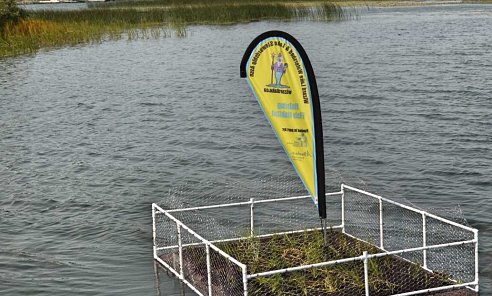
Wizard Lake, SW of Edmonton and North of Pigeon Lake installs BioHavens with multiple purposes in mind:
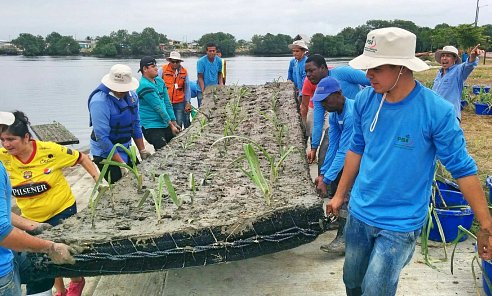
VITA Water Tech (Lethbridge, AB) successfully lead the installation of 4,200 square feet of BioHaven® floating treatment wetlands (FTWs), including two Streambeds, in an estuary in Guayaquil, Ecuador. The purpose of the project was to decontaminate a heavily polluted branch of the Estero Salado, in order to allow the locals to safely swim again and enable the return of marine life. The project commissioned by the Ministry of Environment was implemented by a local environmental company PSI (installation video). Within 6 months the system accomplished the objectives set out by the Ministry. The FTWs were sold by Floating Island International and manufactured by Martin Ecosystems.
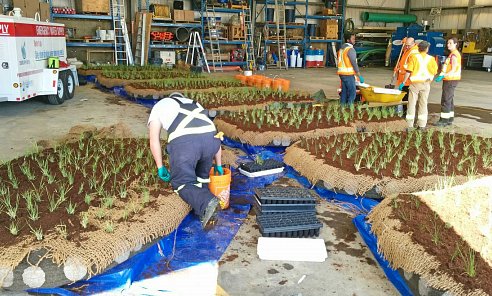
Due to inclement weather the City of Airdrie decided to plant the floating islands indoors. The launch at the City's thrid stormwater pond with islands, Bayside, is planned for the next day.
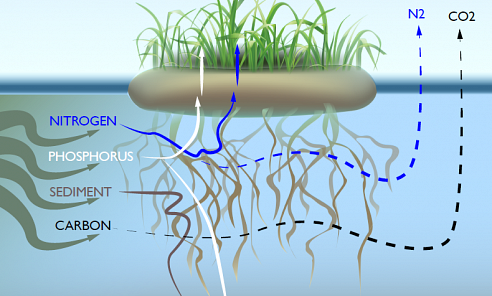
The University of Calgary conducted a two year study on the effects of floating treatment wetlands (FTW) in a wastewater lagoon. The study sponsored by Alberta Environment & Parks and Environment Canada demonstrates that FTWs remove naturally and effectively contaminants from a wastewater facility. This study focused on the fate of phosphorus, nitrogen, organic carbon, and suspended solids, as well as the change in water temperature, pH, electrical conductivity and dissolved oxygen. All of these parameters can have a negative impact on water quality, if not managed properly. View a summary here...of the master thesis highlighting the convincing results and the poster here...with layout of the on site tests.
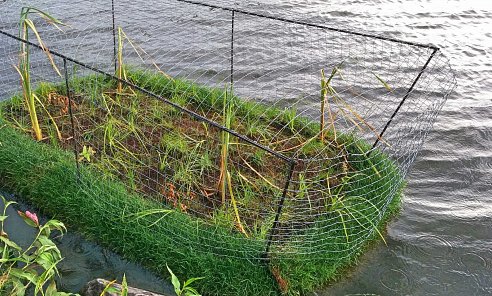
Starland County launches a small floating island at their Michichi Dam to understand and gain knowledge about the technology. The wire cage as seen on the picture is made to initially protect young plant plugs from potentially being destroyed by large birds. Once the plants are fully grown the wire cage can be removed.
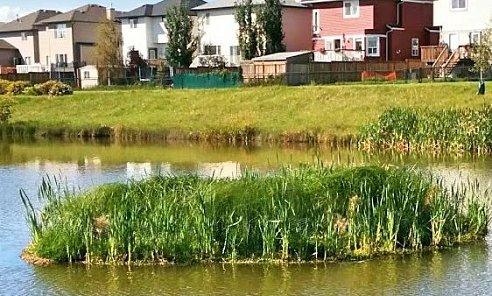
The small sedge and rushes plugs planted on the three BioHaven floating treatment wetlands a year earlier at the Airdrie stormwater pond are thriving. They are cleansing the water, removing nutrients and pollutants.
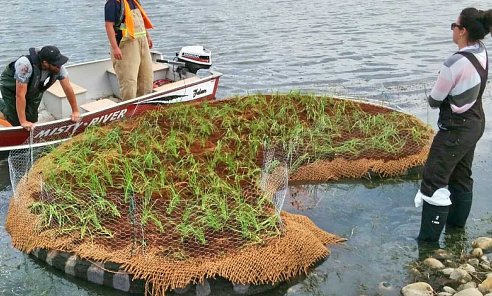
The City of Airdrie launches nine kidney shaped BioHaven floating islands at their Gateway storm pond. The purpose is to manage the water quality of the pond and add a nice visual feature to the water body. A sign at the visitor outlook explains the purpose of stormponds, the water cleansing role of wetlands and enhancement with floating treatment wetlands.
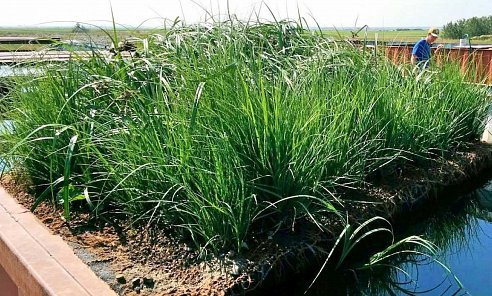
The sedges and rushes planted as small plugs about a year ago (see news below, June 2015) on the BioHaven floating treatment wetlands (FTW) are now flourishing and doing their 'work'. The rigorous research project led by the University of Calgary using floating wetlands in wastewater from the Carseland, Alberta, lagoons is clearly demonstrating the effectiveness of this natural ‘technology’. Contaminants such as phosphorus, ammonia, nitrate, total nitrogen and BOD are significantly reduced.
This passive technology requires no maintenance, is long lasting and therefore more cost effective than other systems. The BioHaven floating treatment wetlands can reduce the required space for new lagoons, can retrofit existing lagoons to increase their capacity or ensure non-compliant lagoons to improve their parameters.
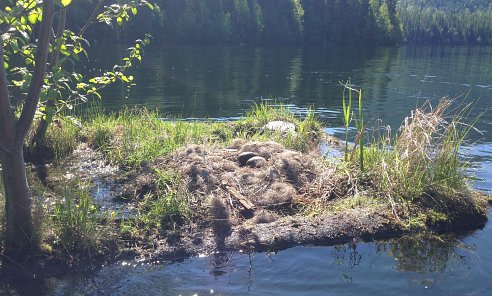
The BioHaven floating islands succesfully foster nesting habitat for ducks, such as Loons and other waterfowl. These islands were first introduced in 2011 at the Flicker lagoon on the Whatsan Lake Reservoir near Revlestoke, BC. Prior to the introduction of the floating islands duck habitats were mostly lost due to fluctuating water levels. In June Kingbird Biological Consultants installed three additional BioHavens as loon nesting platforms in the area.
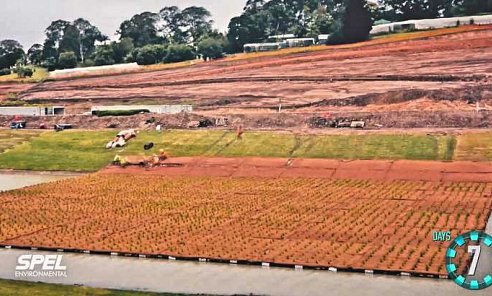
In June ‘Spel Environmental’ installed in the town of Sunshine Coast, Australia, the largest urban floating wetland to treat stormwater runoff and maintain lake water quality.
The BioHavens floating wetlands cover 22,600 sq ft (2,100 m2). The supporting non-woven matrix (structure) of these wetlands are constructed from over 278,000 recycled PET bottles which otherwise go to landfills. The plants, roots and biofilm, as opposed to chemicals that negatively impact the environment, achieve all the bacteria counts and oxygen levels in independent scientific trials and over numerous installation sites.
Automatic samplers are installed to retrieve critical data during storm events. The BioHaven floating islands are easy and inexpensive to maintain when compared to conventional wetland technology. View the details in the video here.. or the video showing the assembly here..
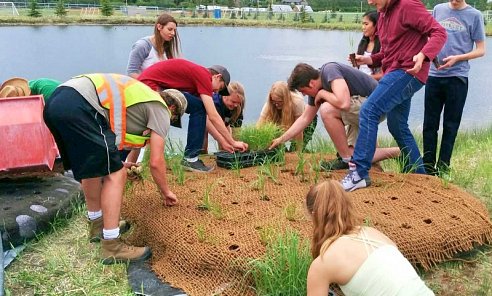
The Agriculture Society, Springbank Park for All Seasons, implements two kidney shaped BioHaven floating islands at their storm pond for water management. Students from the local Springbank high school helped prepare and launch the floating treatment wetlands. As seen on the picture the floating matrix is first covered with a coco coir mat. Small wetland plant plugs are then inserted in the holes which are filled with bio-soil.
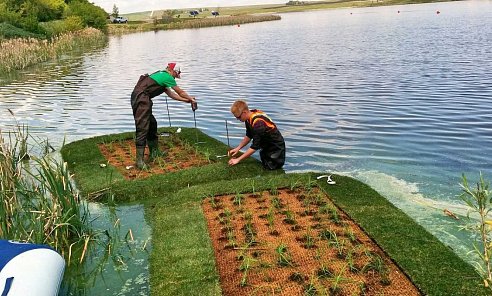
Knee Hill County launches five BioHaven floating treatment wetlands at the 80 acre Swalwell Dam, south of Three Hills, Alberta. The purpose is to improve the water quality of the dam and enhance the fish habitat for the popular fishing area.
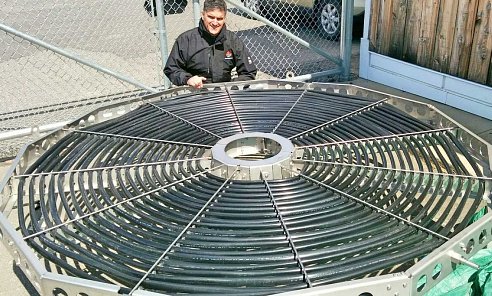
VITA visits the headquarters of CanadianPond.ca in Quebec and becomes a distributor of their advanced water treatment technologies. Bubble Tubing®, more.. is a Canadian designed and fabricated, flexible, micro-bubble air diffuser. The robust and efficient technology is widely applied worldwide in the industry, including mining, petroleum, leachate ponds and aquaculture. The linear tubing is highly efficient in aerating, oxygenating and circulating water in storm water retention ponds, wastewater facilities or lagoons, and long narrow waterways. There are no moving parts or electricity in the water. The same 100' or 300' long Bubble Tubing in a stainless steel frame is called 'OctoAir' (see picture) for powerful aeration, mixing or de-icing. Bacterius™, more.. is a line of cultured beneficial microorganisms to improve water quality in lakes and ponds naturally; the technology is called bio-augmentation. These specially grown microorganisms biodegrade or transform excess nutrients, fats, oil, grease or hydrocarbon based contaminants.
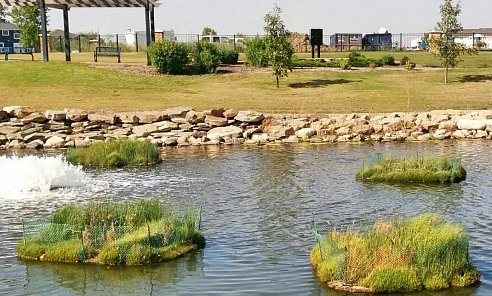
The initial 10 cm tall plugs inserted on the BioHaven floating treatment wetlands (FTW) in June 2014 have fully grown and spread in their second season on the West Highland stormwater pond in Lethbridge. The natural bacteria around the roots of the plants and in the biofilm formed in the floating matrix remove harmful nutrients such as nitrates, ammonia, BOD, phosphorus, suspended solids and other pollutants in urban, rural and industrial water bodies. The FTWs provide an exponentially higher surface area for plants and microbes to thrive in than those found in naturally occurring or constructed wetlands.
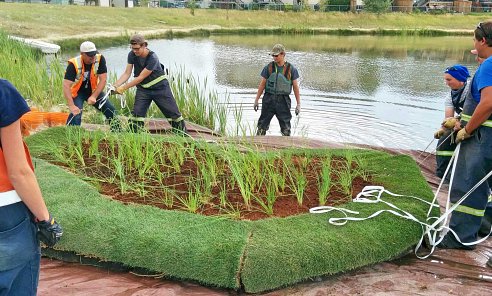
The City of Airdrie launches three large kidney-shaped BioHaven Floating Treatment Wetlands (FTW) at the Luxstone stormwater pond to biologically reduce accumulated contaminants and algae growth. In addition once the wetland plants on the islands have matured they will add an appealing feature to the pond.
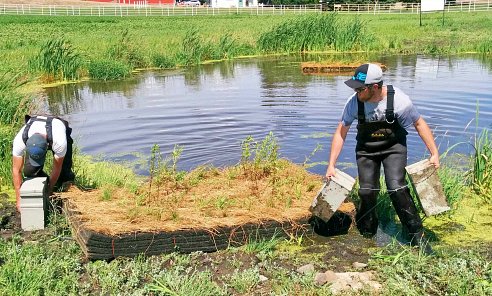
Lakeland College in Alberta launches an experiment to assess the use of biochar as a soil medium on floating islands. However, water sampling and testing was carried out for the duration of this experiment to measure nutrient loads in the water as well. Regarding soil mediums, coconut coir is a popular choice in floating islands as it is a readily available and relatively inexpensive natural product derived from the coconut husks during processing. Biochar is a solid, carbon-rich product derived from the pyrolysis of waste biomass, typically forestry or agricultural residues. This experiment aims to determine whether or not biochar is a suitable soil medium alternative to coconut coir.
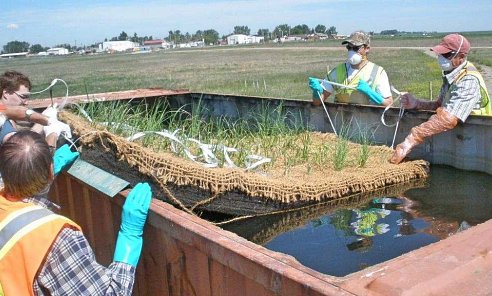
Two 40 ft sea-cans are used to hold wastewater effluent from the Carseland, AB wastewater lagoons. A 3.2m2 BioHaven floating treatment wetland (FTW) was added to the wetland cell of both sea-cans. The storage treatment cells contain water from the storage lagoon; a composite samples is taken from the four corners of every cell, twice a week to monitor the change in water quality over time. The facultative cells are filled with water from the facultative lagoon which is pumped at a rate of 380L/day, giving the cells a hydraulic retention time of 50 days. The two year study is conducted under supervision of the University of Calgary as part of a student master thesis in Environmental Engineering. The sponsors are Environment Canada, Alberta Environment and Parks, NSERC, Wheatland County, University of Calgary, Source2Source, Knutson & Shaw Growers, VITA Water Technologies. Benefits of floating treatment wetlands in wastewater: view the 3 minute video.
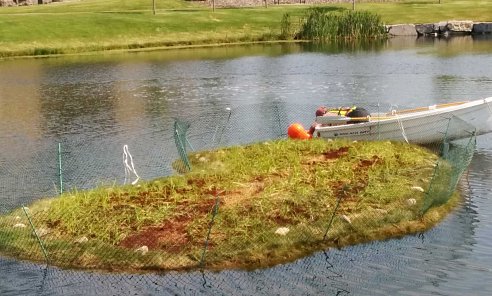
The City of Lethbridge acquires four large kidney-shaped BioHaven Floating Treatment Wetlands for the Prairie Arbour stormwater pond.

VITA Water Technologies and the award winning Clearflow Enviro Systems Group have entered a Joint Venture to provide an integrated solution to improve and maintain water quality in stormwater ponds. Clearflow technology addresses soil and water challenges. The technology separates suspended and colloidal pollutants, metals and toxic materials from water prior to entering the pond. The Clearflow technology in combination with BioHaven floating islands extends the life of stormwater ponds through reduction of sediments at the inflow. Maintenance costs for sediment removal are also reduced. For new ponds, the combined technologies enable a reduced pond footprint and a resulting lower investment cost. From an environmental perspective, the greatest overall benefit is the long-term health of the pond.
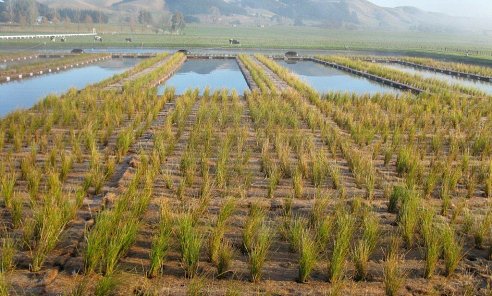
A recent comprehensive study performed by CH2M Hill at Pasco County, Florida confirms high removal rates for total nitrogen (TN) and total phosphorus (TP) on treated wastewater with BioHaven Floating Concentrated Wetlands (FCW). The focus of the study was to determine how FCWs could potentially be used on treated wastewater (reclaimed water) to meet total maximum daily loads (TMDLs) for TN.
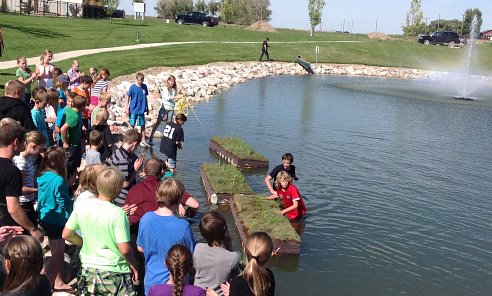
Students from Taber Christian School helped prepare and launch several BioHaven floating islands in the pond of a new housing development. Vita Water Technologies of Lethbridge, worked with students to establish a science project that will involve periodic water testing to gauge the islands’ effectiveness in improving water quality.
“I think every school kid in Alberta should do it, or Western Canada or North America, where instead of complaining about the environment, you go out there and learn what’s going on with our water,” Sid Tams, owner of the development said as he watched students prepare the islands. “This is the future of storm water. You can’t just run it into the river.” Cory Armfelt, Taber’s director of planning and economic development who also watched the launch, said the town supports the concept of a floating laboratory for students. “It seems more holistic to treat water like this,” said Armfelt. (source: Western Producer)
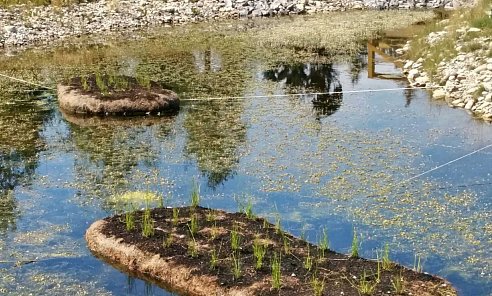
Olds College is interested in verifying the survival rate of the Horsetail plant (Equisetum fluviatile) on BioHaven floating concentrated wetland. In the previous season the Horsetail plant had a 100% failure when installed on the pond shoreline. The Horsetail plant seems to be excellent at absorbing heavy metals as present e.g. in tailing ponds of oilsands extraction facilities. To date, mid September 2014, the plants on the BioHaven are thriving. Olds College has an extensive wetland research facility with 19 different ponds. The water quality of each pond is remotely monitored in real time for 13 variables.
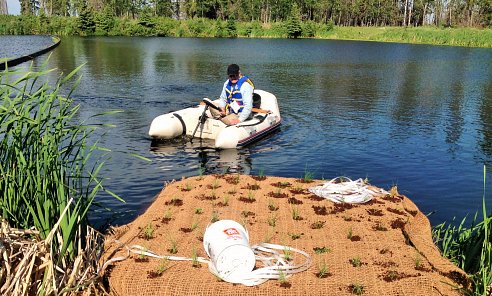
With assistance from the Mackenzie Research Institute and Alberta Agriculture, five BioHaven floating concentrated wetlands were launched in a farm dugout near Fort Vermilion. In conjunction with an aerator the aim is to improve the water quality of the dugout by removing detrimental nutrients and reduce the growth of harmful algae in order to make the water safe as drinking water for animals. Periodic water samples are taken to monitor the evolution of the waterbody.
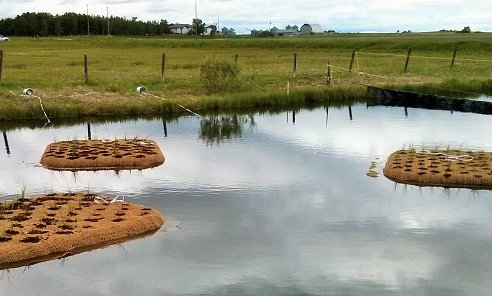
With support from Alberta Agriculture and Environment Canada, three BioHaven floating concentrated wetlands were launched in a farm dugout near Vegreville. The aim is to improve the water quality of the dugout by removing detrimental nutrients and reduce the growth of harmful algae in order to make the water safe as drinking water for animals. Periodic water samples are taken to monitor the evolution of the waterbody.
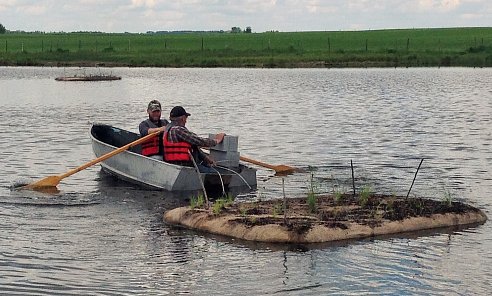
Hiller’s Dam is a public day use area maintained by Mountain View County. It includes a 23-acre water reservoir. Due to the reservoir’s shallowness, the water body is prone to algae blooms, which can cause high fish mortality due to a lack of oxygen. “The six floating islands are being installed to improve the fish habitat, create more riparian habitat, increase biodiversity and improve the water quality of the dam,” said Jane Fulton, MVC manager of agricultural services. The islands are planted with a mixture of native grasses and wetland plants such as sedges, rushes and cattails, she said, noting the plants will absorb sediments and take up nutrients like phosphates, nitrates, ammonia, heavy metals and other pollutants. (source: Mountain View Gazette)
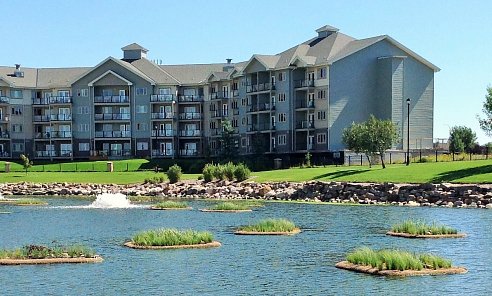
“A clean, environmentally-friendly park system is very important to us and to residents,” says David Ellis, Parks Manager for the City of Lethbridge. “These new floating islands will help to keep the water clean in stormwater ponds, while enhancing the park experience for residents.” Each island will improve water quality for 15 years. (source: City of Lethbridge press release June 6, 2014). The 12 islands in the West Highland stormwater pond add a nice and interesting 'living' feature to the waterscape.